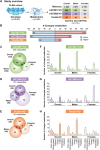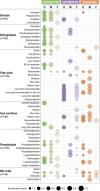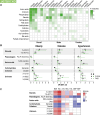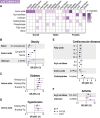Sexual dimorphism in metabolomic and phenotypic spectra of UGT deficiency: findings from the Canadian Longitudinal Study on Aging
- PMID: 40264209
- PMCID: PMC12013048
- DOI: 10.1186/s13293-025-00708-5
Sexual dimorphism in metabolomic and phenotypic spectra of UGT deficiency: findings from the Canadian Longitudinal Study on Aging
Abstract
Background: Two of the most frequently deleted genes in the human genome are the UDP-glycosyltransferases UGT2B17 and UGT2B28. They encode metabolic enzymes of the glucuronidation pathway that plays a pivotal role in the maintenance of cellular homeostasis for a variety of small molecule metabolites. These deletions may impact health, yet their effects remain poorly understood. We evaluated the impact of UGT deficiency on the plasma metabolome and examined the association between altered metabolites and health outcomes.
Methods: The metabolomic profiles of 4262 proficient gene carriers were compared with those of 352 UGT2B17-deficient, 97 UGT2B28-deficient, and 20 double-gene-deficient individuals from the Canadian Longitudinal Study on Aging. Significant metabolites found in these comparisons were analyzed for their associations with common diseases.
Results: The unexpectedly broad molecular divergence found in UGT-deficient metabolomes, which affected > 10% of metabolites, implies their significant influence across various metabolite classes-particularly lipids and amino acids - extending beyond their known substrates. The metabolic profiles of UGT2B17-deficient men and UGT2B28-deficient women were most impacted, with UGT2B17 deficiency affecting various metabolites linked to metabolic diseases, arthritis, and osteoporosis. Metabolites impacted by a UGT2B28 deficiency such as amino acids, were linked to metabolic disorders in women.
Conclusion: The findings significantly advance our understanding of the metabolic landscape associated with these frequently deleted genes in the human genome, which may influence susceptibility to various diseases in a sex-specific manner, laying the groundwork for determining their pathological mechanisms and impact on human health.
Divergent metabolomes of deficient glycosyltransferase individuals (UGT KO).Highest impact of UGT deficiency on lipid profiles.Unique metabolic signatures characterize UGT2B17 KO men and UGT2B28 KO women.UGT KO metabolic signatures are linked to a variety of diseases.
The human body constantly produces a variety of small molecules, including steroids, bile acids, fatty acids, and hormones. UDP-glycosyltransferases (UGTs) are a key family of enzymes that help balance these molecules and remove them from the body through a process called glucuronidation. Interestingly, two UGT genes, UGT2B17 and UGT2B28, are often naturally deleted, meaning some people are born without these genes. This gene absence results in a complete deficiency of the associated UGT proteins, potentially disrupting the balance of certain metabolites in the body. To understand how missing UGT2B17 or UGT2B28 affects the body’s full profile of metabolites (known as the circulating metabolome), we compared individuals without one or both of these genes (deletants) to those with both gene copies (references). We found distinct, sex-specific changes in metabolite levels: men lacking UGT2B17 had higher levels of steroids and phospholipids, while women lacking UGT2B28 had lower levels of fatty acids. Additionally, these disrupted metabolite levels were linked to different diseases in a sex-specific way. These insights help clarify how these commonly deleted genes influence metabolism and may lead to disease, opening avenues for future health research.
Keywords: CLSA; Glycosyltransferase; Human gene knockout; Metabolic disorders; Metabolomics.
© 2025. The Author(s).
Conflict of interest statement
Declarations. Ethics approval and consent to participate: This study was approved by the local ethics committee (CHU de Québec – UL #2012 − 362). All participants provided written informed consent upon enrollment into the CLSA. Consent for publication: Not applicable. Competing interests: The authors declare no competing interests. Disclaimer: The opinions expressed in this manuscript are those of the authors and do not reflect the views of the Canadian Longitudinal Study on Aging. Additional files: File name: Additional file 1 File format. Pdf. Title of data: Supplementary Figures of Sexual Dimorphism in Metabolomic and Phenotypic Spectra of UGT deficiency: Findings from the Canadian Longitudinal Study on Aging. Description of data: Supplementary Fig. 1: Metabolites quantified in this study and number of metabolites in each super-pathway that were available for analysis. Supplementary Fig. 2: Gene expression by sex for (A) UGT2B17 and (B) UGT2B28 in human tissues. Supplementary Fig. 3: Number of significantly altered metabolites in each UGT KO group relative to the gene-proficient reference group (P < 0.05) by subpathway. Supplementary Fig. 4: Relative abundance of significantly dysregulated metabolites in each KO group. Supplementary Fig. 5: Associations between significantly altered metabolites in UGT2B17 KO and diseases. Supplementary Fig. 6: Associations between significantly altered metabolites in UGT2B17 KO females, UGT2B28 KO males, and diseases. File name: Additional file 2: File format. Excel.xlsx. Title of data: Supplementary tables of Sexual Dimorphism in Metabolomic and Phenotypic Spectra of UGT deficiency: Findings from the Canadian Longitudinal Study on Aging. Description of data: Supplementary Table 1: Detail of the chronic diseases / categories of chronic diseases used in this study. Supplementary Table 2: Fold change of the plasma metabolites measured in KO and reference groups. Supplementary Table 2.1: Significant changes in plasma metabolites for postmenopausal women. Supplementary Table 3: Characteristics of the study groups. Supplementary Table 4: Top 5 most changed metabolites in UGT2B17 KO, UGT2B28 KO and Double KO for overall and sex-based analyses. Supplementary Table 4.1: Top 5 most changed metabolites including unknown and partially characterized metabolites in UGT2B17 KO, UGT2B28 KO and Double KO for overall and sex-based analyses.
Figures






Similar articles
-
The liver proteome of individuals with a natural UGT2B17 complete deficiency.Sci Rep. 2025 Feb 14;15(1):5458. doi: 10.1038/s41598-025-89160-4. Sci Rep. 2025. PMID: 39953065 Free PMC article.
-
The effect of copy number variation in the phase II detoxification genes UGT2B17 and UGT2B28 on colorectal cancer risk.Cancer. 2013 Jul 1;119(13):2477-85. doi: 10.1002/cncr.28009. Epub 2013 Apr 10. Cancer. 2013. PMID: 23575887 Free PMC article.
-
Copy-number variations (CNVs) of the human sex steroid metabolizing genes UGT2B17 and UGT2B28 and their associations with a UGT2B15 functional polymorphism.Hum Mutat. 2009 Sep;30(9):1310-9. doi: 10.1002/humu.21054. Hum Mutat. 2009. PMID: 19572376
-
Multiple roles for UDP-glucuronosyltransferase (UGT)2B15 and UGT2B17 enzymes in androgen metabolism and prostate cancer evolution.J Steroid Biochem Mol Biol. 2015 Jan;145:187-92. doi: 10.1016/j.jsbmb.2014.05.009. Epub 2014 May 23. J Steroid Biochem Mol Biol. 2015. PMID: 24861263 Review.
-
Characterization and regulation of UDP-glucuronosyltransferases in steroid target tissues.J Steroid Biochem Mol Biol. 1998 Apr;65(1-6):301-10. doi: 10.1016/s0960-0760(97)00183-0. J Steroid Biochem Mol Biol. 1998. PMID: 9699884 Review.
References
-
- Long T, Hicks M, Yu HC, Biggs WH, Kirkness EF, Menni C, et al. Whole-genome sequencing identifies common-to-rare variants associated with human blood metabolites. Nat Genet. 2017;49(4):568–78. - PubMed
-
- Menard V, Eap O, Harvey M, Guillemette C, Levesque E. Copy-number variations (CNVs) of the human sex steroid metabolizing genes UGT2B17 and UGT2B28 and their associations with a UGT2B15 functional polymorphism. Hum Mutat. 2009;30(9):1310–9. - PubMed
-
- McCarroll SA, Hadnott TN, Perry GH, Sabeti PC, Zody MC, Barrett JC, et al. Common deletion polymorphisms in the human genome. Nat Genet. 2006;38(1):86–92. - PubMed
MeSH terms
Substances
Grants and funding
LinkOut - more resources
Full Text Sources
Medical

